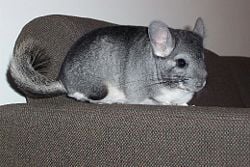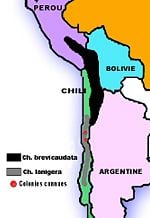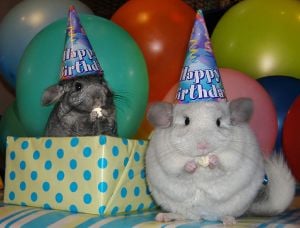Difference between revisions of "Chinchilla" - New World Encyclopedia
Rick Swarts (talk | contribs) (added article from wikipedia and credit/category tags) |
Rick Swarts (talk | contribs) |
||
| Line 76: | Line 76: | ||
== References == | == References == | ||
| − | {{ | + | |
| − | + | {{reflist}} | |
| − | + | ||
| + | Myers, P. 2000. "Chinchillidae" (On-line), Animal Diversity Web. Accessed August 20, 2008 at http://animaldiversity.ummz.umich.edu/site/accounts/information/Chinchillidae.html. | ||
== External links == | == External links == | ||
Revision as of 02:29, 21 August 2008
- For other uses, see Chinchilla (disambiguation).
| Chinchilla
| ||||||||||||
|---|---|---|---|---|---|---|---|---|---|---|---|---|
 | ||||||||||||
| Scientific classification | ||||||||||||
| ||||||||||||
 Range map of Chinchilla species.
Red dots = Last known families (Ch. lanigera). | ||||||||||||
|
Chinchilla lanigera |
Chinchillas are rabbit-sized, crepuscular rodents native to the Andes mountains in South America. Along with their relatives, viscachas, they belong to the family Chinchillidae.
History
The animal (whose name literally means "little Chincha") is named after the Chincha people of the Andes, who wore its soft and dense fur.[1] By the end of the 19th century, chinchillas had become quite rare due to hunting for their fur. Most chinchillas currently used by the fur industry for clothing and other accessories are farm-raised.[2]
The first literature reference to chinchillas dates back to 1599 in a book published in Seville, entitled Historia Natural y Moral de las Indias, written by Father José de Acosta: (from Spain) "About mountain animals. Chinchillas are another type of small animals such as squirrels. They have a fur (coat) that is of wonderful softness".[3]
One of the first people to think of breeding chinchillas for profit was the Jesuit priest Juan Ignacio Molina, who was also the first person to provide an accurate description of Chinchilla in 1810. There were repeated attempts to breed these animals in captivity. The first reliable report of successful breeding attempt in captivity comes from Frederico Albert (1900), who was director of the zoological and botanical research station at Santiago, Chile. He reports in his article "La Chinchilla" about a certain Francisco Irrazaval in Santiago who had received a pair of chinchillas (presumably Chinchilla lanigera) in 1895. The first chinchilla was born that same year and the pair continued to produce 2 litters a year until the outbreak of an epidemic during the summer of 1896 ruined this excellent breeding success, and all the animals, 13 at that time, died within a period of two months.[3]
Mathias F. Chapman, a mining engineer from California, was working in Chile in 1918 when he purchased a chinchilla as a pet and took a liking to it. He envisioned raising a whole herd of chinchillas and he applied to the Chilean government for permission to capture and transport several animals to the US. At this point, chinchillas were already close to extinction from humans killing them for the fur trade. The Chilean government was reluctant to grant trapping permission, but Chapman persisted, and eventually the government allowed him to catch them.[4]
Chapman and a group of men searched the mountain for three years and caught only eleven chinchillas. He then took the 12,000 ft (3,700 m) climb down over a period of twelve months so the chinchillas could acclimate to the changing environment. He then brought the eleven wild chinchillas he had captured to the United States for breeding, where he started the first chinchilla farm. Only three of these chinchillas were female. This was the beginning of the domestic chinchilla.[5] Since the mid-1960s, chinchillas have become increasingly popular as house pets.
Native environment
In their native habitat, chinchillas live in burrows or crevices in rocks. They are agile jumpers and can jump very high, up to 5 ft (1.5 m). Predators in the wild include hawks, skunks, felines, and canines. Chinchillas have a variety of defence tactics including spraying urine and releasing fur if bitten.[6] In the wild, chinchillas have been observed eating plants, fruits, seeds, and small insects,[7] though this diet could irritate the digestive system of a domestic chinchilla whose diet should be primarily hay-based.[8]
In nature, chinchillas live in colonies. Chinchilla females are significantly bigger than males. Chinchillas can breed any time of the year. At 111 days, they have a very long gestation period compared to other rodents. Due to this long pregnancy, chinchillas are born fully furred and with eyes open. Litters are usually small in number, predominately twins.[9]
Chinchilla species
There are two living species of chinchilla, Chinchilla brevicaudata and Chinchilla lanigera. There is little noticeable difference between the species except that the Chinchilla brevicaudata has a shorter tail, a thicker neck and shoulders, and shorter ears. This species is currently facing extinction.[5] The Chinchilla lanigera species, though rare, can be found in the wild.[7] Domestic chinchillas are thought to come from the lanigera species.[10] The Giant Chinchilla species has been hunted to extinction.[11]
Fur industry
The international trade in chinchilla fur goes back to the 16th century. The fur from chinchillas is popular in the fur trade due to its extremely soft feel, because they have about 60 hairs sprouting from each hair follicle. The color is usually very even which makes it ideal for small garments or lining of large garments, though some large garments can be made entirely from the fur. The pelt of a chinchilla is relatively small, so many animals must be killed to make a single coat. This fact led to the extinction of one species, and put serious pressure on the other two. Though wild chinchillas are no longer hunted for their fur, domestic chinchillas are still bred for this use.[12]
Chinchillas as pets
Domestic chinchillas can be kept as pets. Chinchillas are crepuscular and typically do not like to be disturbed during the day, which may make them less favorable as pets to some people. Chinchillas are naturally very skittish creatures and generally do not like to be held, although they can become very attached to their owners if they grow up without a cage mate. Because of their high-strung disposition, they are not usually considered to be good pets for small children. However, chinchillas can be very friendly animals if sufficiently acclimated to human touch as kits, making them excellent pets for patient owners. [13]
Male chinchillas tend to be easier to handle because they are not subject to temperament fluctuations due to the estrus cycle.
Captive chinchillas commonly live 15 years, but some have been known to live up to 20 or more.[14] Currently (as of 2008), the world's oldest chinchilla is 27 years old and resides in the UK. The oldest chinchilla in America lived to be 26. [15]
Chinchillas make a variety of vocalizations, including chirps, squeaks, and barks. They use these sounds to express themselves, from a calm, loving chirp given to a potential mate to a loud, aggressive bark when threatened. Chinchilla kits often greet their parents with a very high pitch chirp, usually to indicate that they are hungry.[16] The first scientific study on chinchilla sounds in their social environment was conducted by Dr. vet. med. Bartl in Germany. [17] Since they are active at night, it is not uncommon for them to vocalize in the early hours of the morning. If irritated or frightened, the female chinchillas may cluck loudly and spray urine at the offender.
Chinchillas can be housed with others of the same sex; however, it is possible that they may fight. Fighting or getting along depends on the individual animals. If the chinchillas are either introduced when young, or gradually introduced when older, conflict can be reduced. Males and females usually get along well, although they must be spayed or neutered to avoid reproduction. However, reproduction rates are low with up to two litters per year of 1-3 kits (3 being rare).
Since chinchillas are very active animals, it is best to house them in a large enclosure, such as a room of their own instead of a small cage. If kept in a cage, the chinchillas need to have a large area replete with shelves or other obstacles on which to play. The cage should be taller than it is wide, as the chinchilla's natural environment is very mountainous. Chinchillas also need other forms of stimulation, such as hanging wooden toys, large wheels (over 16 in (410 mm) in diameter and not constructed of mesh, as chinchilla legs and toes can easily get caught), or paper towel tubes. Wooden sticks and chew toys are also good options, but conifer woods (especially cedar) should be avoided because of the high content of resins that are toxic for chinchillas. Birch, willow, apple tree or manzanita are all safe woods for chinchillas to chew.[18] Plastic in the cage should be avoided at all times. Chinchillas are often voracious chewers, and any ingested plastic can cause blockage in the intestines. As with most small animals, red cedar bedding should never be used due to its toxic nature.[19] The cage must have good air circulation. The chinchilla lacks the ability to sweat; therefore, if temperatures get above 25°C (80°F), the chinchilla could get overheated and may suffer from heat stroke.[20]
Active and inquisitive by nature, chinchillas need to spend some time outside of the cage (around half an hour a day and always supervised) to exercise and to satisfy their curiosity. Chinchillas will chew on inappropriate items including electrical cords.
Chinchillas can be found in a variety of colors including the standard gray (the only color found in nature), beige, ebony, and many others.[21] They instinctively clean their fur by taking dust baths several times a week, in which they roll around in a container full of special chinchilla dust made of sand or fine pumice. The dust gets into their coat of fur and absorbs oil. Chinchillas do not bathe in water because the density of their fur retains moisture close to the skin, which can cause fungus growth or rot.[22]
Chinchillas eat and digest desert grasses and cannot efficiently process fatty foods or too many green plants. A high quality, hay-based pellet and a constant supply of loose hay will sufficiently meet all of their dietary needs. Chinchillas have very sensitive GI tracts that can be easily disrupted so it is important to maintain them on a healthy diet.[23] Some Chinchilla feed includes raisins as part of the mix. Fresh vegetables (with high moisture content) should be avoided as these can cause bloat in a chinchilla, which can be fatal. Chinchillas also eat and drink in very small amounts, therefore, overfeeding is easy.[24] This can lead to diarrhea, or in the long term, diabetes. Nuts should be avoided due to their high fat content.[25]
In scientific research
Because the chinchilla range of hearing (20 Hz to 30 kHz) is close to that of a human and the chinchilla cochlea is fairly easy to access, it is often used as an animal model in researching the auditory system.[26] Other research fields in which chinchilla is used as an animal model include study of Chagas disease, Gastrointestinal diseases, Pneumonia, Listeriosis, as well as of Yersinia and Pseudomonas infections.
See also
- Viscacha
ReferencesISBN links support NWE through referral fees
- ↑ What Is A Chinchilla?. Davidson Chinchillas. Retrieved 2008-02-01.
- ↑ http://www.chincare.com/HealthLifestyle/JEJ/JEJExtirpation1995.pdf
- ↑ 3.0 3.1 Bickel, Edmund (1987), Chinchilla Handbook, Neptune City, NJ: T.F.H. Publications, Inc., ISBN 0-86622-494-7
- ↑ Scott Barnes (August 2002). Chinchilla History. Mutation Chinchilla Breeders Association. Retrieved 2008-02-01.
- ↑ 5.0 5.1 http://chin.dk/eng/facts.html
- ↑ Is a Chinchilla the pet for me?. Fantastic Chinchillas. Retrieved 2008-02-01.
- ↑ 7.0 7.1 Chinchilla (Chinchilla lanigera). Comparative Mammalian Brain Collections. Retrieved 2008-02-01.
- ↑ Nutrition. chincare.com. Retrieved 2008-02-01.
- ↑ The Chinchilla. Chinchilla Lexicon (2003-05-01). Retrieved 2008-02-01.
- ↑ Chinchillas, Chinchillidae, Chinchilla lanigera, Chinchilla brevicaudata
- ↑ The Chinchillaburg, last update 6th of November 2007
- ↑ Chinchillas Endangered Species Handbook
- ↑ Welcome to the Chinchilla Information Pages
- ↑ Chinchillas as Pets - Profile of Chinchillas and Chinchilla Facts
- ↑ http://209.85.165.104/search?q=cache:K1MQYit2hn0J:www.chinchillas4life.co.uk/+world%27s+oldest+chinchilla&hl=en&ct=clnk&cd=1&gl=us&client=safari
- ↑ The Sounds Made by the Chinchillas
- ↑ Bartl, Dr. vet. med. Juliana (2008), Chinchillas, Munich, Germany: GU Verlag GmbH, ISBN 978-3-8338-1165-4
- ↑ safewoods
- ↑ Cedar and Pine Wood Shavings - Problems and Toxicity
- ↑ Heat Stroke
- ↑ Garden City Chinchillas
- ↑ Grooming, Fur and Skin Health- chincare.com
- ↑ http://www.chincare.com/HealthLifestyle/NutritionDental.htm
- ↑ m s home shopping next at naturecoastchinchillas.com
- ↑ http://www.chincare.com/HealthLifestyle/NutritionDental.htm#treats
- ↑ PIR: Chinchilla
Myers, P. 2000. "Chinchillidae" (On-line), Animal Diversity Web. Accessed August 20, 2008 at http://animaldiversity.ummz.umich.edu/site/accounts/information/Chinchillidae.html.
External links
- Save the Wild Chinchillas - An organization dedicated to preserving wild chinchilla populations.
Template:Chinchillidae nav
Credits
New World Encyclopedia writers and editors rewrote and completed the Wikipedia article in accordance with New World Encyclopedia standards. This article abides by terms of the Creative Commons CC-by-sa 3.0 License (CC-by-sa), which may be used and disseminated with proper attribution. Credit is due under the terms of this license that can reference both the New World Encyclopedia contributors and the selfless volunteer contributors of the Wikimedia Foundation. To cite this article click here for a list of acceptable citing formats.The history of earlier contributions by wikipedians is accessible to researchers here:
The history of this article since it was imported to New World Encyclopedia:
Note: Some restrictions may apply to use of individual images which are separately licensed.





